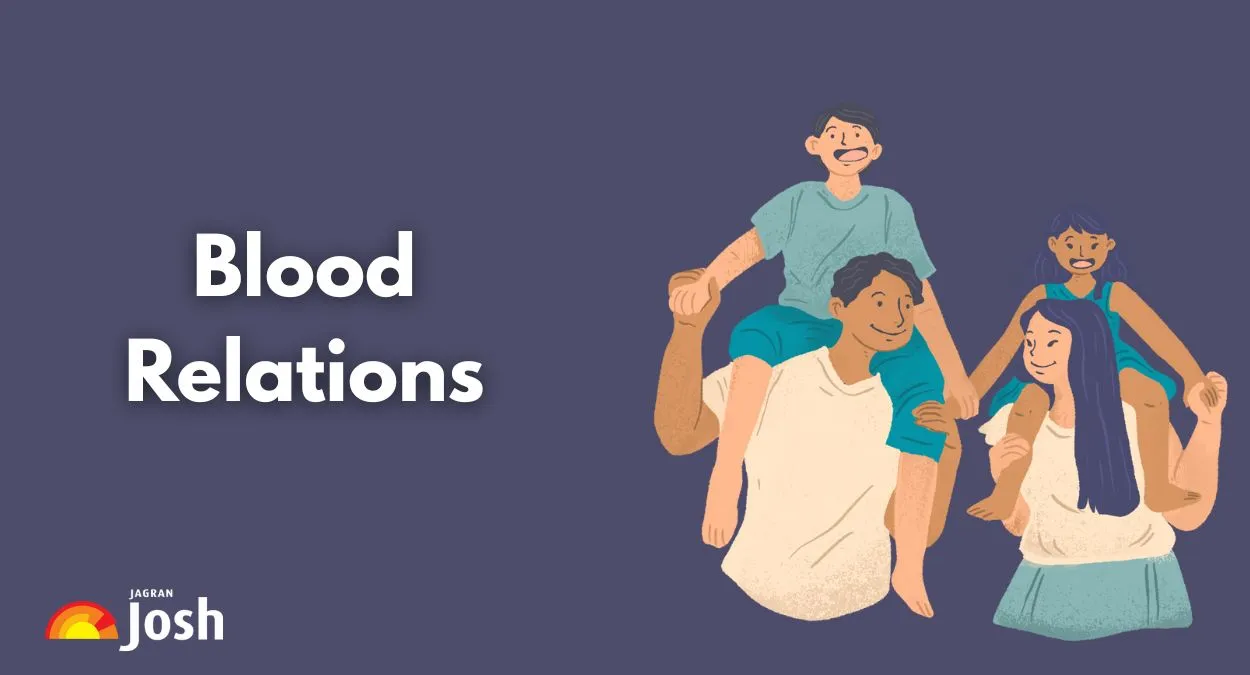Blood relations is a common logical reasoning topic. Candidates have to identify the relationship between family members based on given information. Blood relations reasoning questions often appear in the form of direct statements or coded puzzles. It test ability to identify family connections through logic.
Many competitive exams, including SBI PO, RRB NTPC, RRB ALP, IBPS RRB, and many more, regularly ask this type of reasoning. It is necessary for candidates preparing for competitive exams to have a thorough understanding of family terms (such as uncle, cousin, and mother-in-law) and to practice answering questions a lot.
To assist with preparation, we will go over the basic concepts and provide answers to the blood relations questions.
Blood Relations Concept in Reasoning
Blood relations reasoning is a frequent topic in competitive exams. To successfully answer these questions, candidates must have a solid understanding of common family relationships and how they are interconnected.
The following are the key types of family relations candidates should know:
Parental Relations: Father (F), Mother (M)
Sibling Relations: Brother (B), Sister (S)
Grandparent Relations: Grandfather (GF), Grandmother (GM)
Marital Relations: Husband (H), Wife (W)
Child Relations: Son (S), Daughter (D)
When solving blood relation questions, it helps to visualize the connections using family trees or diagrams. This method makes it easy to identify connections and arrive at logical conclusions.
Types of Blood Relations Questions in Reasoning
To properly solve blood relations reasoning questions, candidates must first know the many patterns in which they can exist. Below are the major types of Blood Relations MCQs commonly asked in competitive exams:
1. Pointing or Introducing Type
This type involves introducing someone by pointing out their relationship to another. Candidates must use the provided statement to determine the relationship between two individuals.
Example: A woman says, “He is my father’s brother’s son.”
Question: How is the man related to the woman’s father?
Answer: Cousin
2. Family Tree Type
Family tree diagrams act as the basis for these questions. Candidates are asked to identify links after being presented with interconnections in the form of a list or chart.
Example: A is the father of B, B is the sister of C, and C is the mother of D.
Question: What is the relationship between A and D?
Answer: Grandfather
3. Coded Relations
Relations between families are symbolized by letters or symbols in this form. Candidates must use the provided key to decode the meaning.
Example: If M = Mother, F = Father, S = Son, D = Daughter
Question: What does the code FMSD mean?
Answer: Father is the husband of Mother; they have a Son and a Daughter.
4. Mixed Blood Relations
This type includes a combination of pointing, coding, and family tree-based logic. It is more complex and tests multiple reasoning skills.
Example: A man says, “Her mother’s brother is my mother’s father’s only son.”
Question: How is the girl's mother related to the man?
Answer: Sister
5. Puzzle-Based Blood Relations
These are logic puzzles involving family structures. Candidates must analyze the entire scenario to answer the questions correctly.
Example: A family has three generations. The grandfather has two sons and one daughter. Each son has two kids, and the daughter has one child.
Question: How many grandchildren does the grandfather have?
Answer: 5 grandchildren
6. Single-Person Blood Relation
This type focuses on how one individual is related to another based on a direct relationship description.
Example: A woman says, “My brother’s son’s sister is my niece.”
Question: How is the woman related to her niece?
Answer: Aunt
Frequently Asked Blood Relations Questions With Answers
The following are some blood relations questions with answers that are frequently asked in government exams:
Question 1: Rohan says, "He is the son of my father’s only daughter." How is the person related to Rohan?
(a) Nephew
(b) Cousin
(c) Brother
(d) Son
Answer: (d) Son
Question 2: A man says, "The person sitting beside me is my wife’s brother’s daughter." How is the person related to the man?
(a) Niece
(b) Daughter
(c) Sister-in-law
(d) Cousin
Answer: (a) Niece
Question 3: If A is the son of B, B is the daughter of C, and C is the wife of D. How is A related to D?
(a) Son
(b) Grandson
(c) Nephew
(d) Cousin
Answer: (b) Grandson
Question 4: A woman says, “My father-in-law is the only brother of my mother.” How is the husband of woman related to her mother?
(a) Nephew
(b) Brother
(c) Son
(d) Cousin
Answer: (a) Nephew
Question 5: Anil says, “She is the daughter of the only sister of my father.” How is the girl related to Anil?
(a) Cousin
(b) Sister
(c) Aunt
(d) Niece
Answer: (a) Cousin
Question 6: If P is the father of Q, and Q is the father of R, and R is the brother of S, how is Q related to S?
(a) Grandfather
(b) Father
(c) Uncle
(d) Cousin
Answer: (b) Father
Question 7: A says, “My mother's husband’s only son is B.” How is A related to B?
(a) Father
(b) Brother
(c) Cousin
(d) Son
Answer: (b) Brother
Question 8: Sunita says, "He is the son of my grandfather’s only son." How is the man related to Sunita?
(a) Uncle
(b) Father
(c) Brother
(d) Cousin
Answer: (c) Brother
Question 9: If A is the sister of B, and B is the brother of C, and C is the son of D, then how is D related to A?
(a) Father
(b) Mother
(c) Parent
(d) Aunt
Answer: (c) Parent
Question 10: A woman says, "He is the husband of the only daughter of my father." How is the man related to the woman?
(a) Brother
(b) Brother-in-law
(c) Father
(d) Husband
Answer: (d) Husband
Related Articles:
